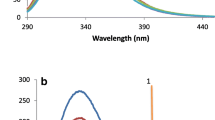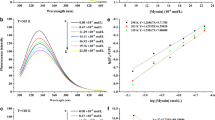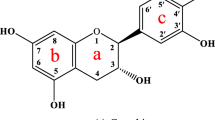Abstract
Polyphenol compounds can modify myofibrillar proteins to improve the quality of fish and surimi. Nevertheless, research into the precise mechanisms of interaction between phenolic substances and sea bass myofibrillar proteins is lacking. This study aimed to explore the interaction mechanism between five phenolic compounds (caffeic acid (CFA), gallic acid (GA), chlorogenic acid (CHA), resveratrol (RES), and catechin (CAT)) with sea bass myofibrillar protein (MP). The results of UV–vis absorption spectroscopy, Fourier transform infrared (FT-IR) spectroscopy, and fluorescence spectroscopy (namely, multi-spectroscopy) showed that all five phenolic compounds could spontaneously form new complexes with MP, with a binding molar ratio of 1:1. The interaction between CFA and MP is predominantly electrostatic, while the interaction between GA and MP is mainly hydrophobic. The rest of phenolic compounds and MP are mediated by hydrogen bonds and van der Waals forces. And molecular dynamics (MD) simulations indicated that CHA-myosin had the minimum root mean square deviation, while CFA-myosin had the smallest Rg value. In addition, the amino acid Lys-179 was the key residue for the interaction between five phenolic compounds and myosin. This study contributes to a better understanding of the interaction between phenolic compounds and sea bass MP, which could develop the processing of aquatic food products.








Similar content being viewed by others
Data Availability
The complete data are available upon request from the corresponding author.
References
Anderson, J. S., Hernández, G., & Lemaster, D. M. (2013). Assessing the chemical accuracy of protein structures via peptide acidity. Biophysical Chemistry, 171, 63–75. https://doi.org/10.1016/j.bpc.2012.10.005
Baba, W. N., McClements, D. J., & Maqsood, S. (2021). Whey protein–polyphenol conjugates and complexes: Production, characterization, and applications. Food Chemistry. https://doi.org/10.1016/j.foodchem.2021.130455
Bakry, A. M., Huang, J., Zhai, Y., & Huang, Q. (2019). Myofibrillar protein with κ- or λ-carrageenans as novel shell materials for microencapsulation of tuna oil through complex coacervation. Food Hydrocolloids, 96, 43–53. https://doi.org/10.1016/j.foodhyd.2019.04.070
Cai, L., Li, X., Wu, X., Lv, Y., Liu, X., & Li, J. (2014). Effect of chitosan coating enriched with ergothioneine on quality changes of Japanese sea bass (Lateolabrax japonicas). Food and Bioprocess Technology, 7(8), 2281–2290. https://doi.org/10.1007/S11947-013-1215-4
Cai, L., Nian, L., Cao, A., Zhang, Y., & Li, X. (2020). Effect of carboxymethyl chitosan magnetic nanoparticles plus herring antifreeze protein on conformation and oxidation of myofibrillar protein from red sea bream (Pagrosomus major) after freeze-thaw treatment. Food and Bioprocess Technology, 13(2), 355–366. https://doi.org/10.1007/S11947-019-02384-X
Chen, Z., Dai, Z., Liu, C., Wang, S., Li, J., & Mao, X. (2024). Microbial transglutaminase promotes cross-linking for enhancing gelation of myofibrillar protein in frozen Litopenaeus vannamei through deamination reaction. Food Hydrocolloids. https://doi.org/10.1016/j.foodhyd.2023.109332
Cheng, J., Liu, J. H., Prasanna, G., & Jing, P. (2017). Spectrofluorimetric and molecular docking studies on the interaction of cyanidin-3-O-glucoside with whey protein, β-lactoglobulin. International Journal of Biological Macromolecules, 105, 965–972. https://doi.org/10.1016/j.ijbiomac.2017.07.119
Dai, S., Lian, Z., Qi, W., Chen, Y., Tong, X., Tian, T., Lyu, B., Wang, M., Wang, H., & Jiang, L. (2022). Non-covalent interaction of soy protein isolate and catechin: Mechanism and effects on protein conformation. Food Chemistry, 384, 132507. https://doi.org/10.1016/J.FOODCHEM.2022.132507
El-Messery, T. M., Mwafy, E. A., Mostafa, A. M., El-Din, H. M. F., Mwafy, A., Amarowicz, R., & Ozçelik, B. (2020). Spectroscopic studies of the interaction between isolated polyphenols from coffee and the milk proteins. Surfaces and Interfaces. https://doi.org/10.1016/j.surfin.2020.100558
Gaspar, A. L. C., & De Góes-Favoni, S. P. (2015). Action of microbial transglutaminase (MTGase) in the modification of food proteins: A review. Food Chemistry, 171, 315–322. https://doi.org/10.1016/j.foodchem.2014.09.019
Han, P., An, N., Yang, L., Ren, X., Lu, S., Ji, H., Wang, Q., & Dong, J. (2022). Molecular dynamics simulation of the interactions between sesamol and myosin combined with spectroscopy and molecular docking studies. Food Hydrocolloids. https://doi.org/10.1016/j.foodhyd.2022.107801
Huang, Y., Du, H., Kamal, G. M., Cao, Q., Liu, C., Xiong, S., Manyande, A., & Huang, Q. (2020). Studies on the binding interactions of grass carp (Ctenopharyngodon idella) myosin with chlorogenic acid and rosmarinic acid. Food and Bioprocess Technology, 13(8), 1421–1434. https://doi.org/10.1007/S11947-020-02483-0/METRICS
Kumar Verma, A., Kumar, V., Singh, S., Goswami, B. C., Camps, I., Sekar, A., Yoon, S., & Lee, K. W. (2021). Repurposing potential of Ayurvedic medicinal plants derived active principles against SARS-CoV-2 associated target proteins revealed by molecular docking, molecular dynamics and MM-PBSA studies. Biomedicine and Pharmacotherapy. https://doi.org/10.1016/J.BIOPHA.2021.111356
Lan, T., Dong, Y., Zheng, M., Jiang, L., Zhang, Y., & Sui, X. (2020). Complexation between soy peptides and epigallocatechin-3-gallate (EGCG): Formation mechanism and morphological characterization. Food Science and Technology. https://doi.org/10.1016/j.lwt.2020.109990
Li, X., Liu, C., Wang, J., Li, W., Lin, B., Zhu, W., Xu, Y., Yi, S., Mi, H., & Li, J. (2020). Tea polyphenols affect oxidative modification and solution stability of myofibrillar protein from grass carp (Ctenopharyngodon idellus). Food Biophysics, 15(4), 397–408. https://doi.org/10.1007/S11483-020-09635-X
Li, Y., Li, M., Li, Q., Geng, F., Wang, Q., Gan, N., Li, S., & Wu, D. (2023). Revealing the potential of theaflavin to reduce egg allergenicity at the molecular level: A study of the binding affinity of theaflavin to egg white lysozyme. Food and Bioprocess Technology. https://doi.org/10.1007/S11947-023-03298-5
Lian, Z., Yang, S., Cheng, L., Liao, P., Dai, S., Tong, X., Tian, T., Wang, H., & Jiang, L. (2023). Emulsifying properties and oil–water interface properties of succinylated soy protein isolate: Affected by conformational flexibility of the interfacial protein. Food Hydrocolloids. https://doi.org/10.1016/J.FOODHYD.2022.108224
Lin, D., Zhang, L., Li, R., Zheng, B., Rea, M. C., & Miao, S. (2019). Effect of plant protein mixtures on the microstructure and rheological properties of myofibrillar protein gel derived from red sea bream (Pagrosomus major). Food Hydrocolloids, 96, 537–545. https://doi.org/10.1016/j.foodhyd.2019.05.043
Lin, J., Sun, P., Zhao, Y., Du, X., Ren, X., Man, H., & Li, D. (2023). Effect of L-lysine on heat-induced aggregation behavior of Antarctic krill (Euphausia superba) Myofibrillar Protein. Food and Bioprocess Technology, 1–14. https://doi.org/10.1007/S11947-023-03205-Y/METRICS
Lu, Y., Zhao, R., Wang, C., Zhang, X., & Wang, C. (2022). Deciphering the non-covalent binding patterns of three whey proteins with rosmarinic acid by multi-spectroscopic, molecular docking and molecular dynamics simulation approaches. Food Hydrocolloids. https://doi.org/10.1016/J.FOODHYD.2022.107895
Manzoor, M., Tchameni, Z. F. N., Bhat, Z. F., Jaiswal, A. K., & Jaglan, S. (2023). Recent insights on the conformational changes, functionality, and physiological properties of plant-based protein–polyphenol conjugates. Food and Bioprocess Technology. https://doi.org/10.1007/S11947-023-03212-Z
Maria Leena, M., Yoha, K. S., Moses, J. A., & Anandharamakrishnan, C. (2020). Edible coating with resveratrol loaded electrospun zein nanofibers with enhanced bioaccessibility. Food Bioscience, 36, 100669. https://doi.org/10.1016/J.FBIO.2020.100669
Nuerjiang, M., Li, Y., Yue, X., Kong, B., Liu, H., Wu, K., & Xia, X. (2023). Analysis of inhibition of guava (Psidium guajava l.) leaf polyphenol on the protein oxidative aggregation of frozen chicken meatballs based on structural changes. Food Research International, 164, 112433. https://doi.org/10.1016/j.foodres.2022.112433
Ozdal, T., Capanoglu, E., & Altay, F. (2013). A review on protein-phenolic interactions and associated changes. Food Research International, 51(2), 954–970. https://doi.org/10.1016/j.foodres.2013.02.009
Paul, S. K., Saddam, M., Rahaman, K. A., Choi, J. G., Lee, S. S., & Hasan, M. (2022). Molecular modeling, molecular dynamics simulation, and essential dynamics analysis of grancalcin: An upregulated biomarker in experimental autoimmune encephalomyelitis mice. Heliyon, 8(10), e11232. https://doi.org/10.1016/J.HELIYON.2022.E11232
Rampogu, S., Shaik, B., Kim, J. H., Jung, T. S., Ha, M. W., & Lee, K. W. (2023). Explicit molecular dynamics simulation studies to discover novel natural compound analogues as Mycobacterium tuberculosis inhibitors. Heliyon, 9(2), e13324. https://doi.org/10.1016/J.HELIYON.2022.E11232
Santana, D. V. S., Trindade, I. A. S., Carvalho, Y. M. B. G., Carvalho-Neto, A. G., Silva, E. C. D., Silva-Júnior, E. F., Leite, R. F. S., Quintans-Júnior, L. J., Aquino, T. M., Serafini, M. R., Guterres, S. S., Scotti, L., Scotti, M. T., Araújo, A. A. S., Frank, L. A., & Menezes, P. P. (2021). Analytical techniques to recognize inclusion complexes formation involving monoterpenes and cyclodextrins: A study case with (–) borneol, a food ingredient. Food Chemistry. https://doi.org/10.1016/j.foodchem.2020.127791
Su, C., He, Z., & Li, H. (2022). Covalent interactions between rabbit myofibrillar proteins and quercetin: A promising approach to enhance protein antioxidant capacity and thermal stability. Food Science and Technology. https://doi.org/10.1016/j.lwt.2022.114132
Sun, F., Wang, H., Liu, Q., Kong, B., & Chen, Q. (2021). Effects of temperature and pH on the structure of a protease from Lactobacillus brevis R4 isolated from Harbin dry sausage and molecular docking of the protease to the meat proteins. Food Bioscience. https://doi.org/10.1016/j.fbio.2021.101099
Tan, C., Xu, Q. D., Chen, N., He, Q., & Zeng, W. C. (2023). Cross-linking modifications of different phenolic compounds on myofibrillar protein of common carp. Food and Bioprocess Technology, 16(3), 627–638. https://doi.org/10.1007/S11947-022-02958-2/METRICS
Vate, N. K., & Benjakul, S. (2016). Effect of the mixtures of squid ink tyrosinase and tannic acid on properties of sardine surimi gel. Journal of Food Science and Technology, 53(1), 411–420. https://doi.org/10.1007/S13197-015-1974-1
Wang, H., You, S., Wang, W., Zeng, Y., Su, R., Qi, W., Wang, K., & He, Z. (2022). Laccase-catalyzed soy protein and gallic acid complexation: Effects on conformational structures and antioxidant activity. Food Chemistry. https://doi.org/10.1016/j.foodchem.2021.131865
Wang, T., Wang, N., Yu, Y., Yu, D., Xu, S., & Wang, L. (2023a). Study of soybean protein isolate-tannic acid non-covalent complexes by multi-spectroscopic analysis, molecular docking, and interfacial adsorption kinetics. Food Hydrocolloids. https://doi.org/10.1016/j.foodhyd.2022.108330
Wang, M., Kang, J., Chen, L., He, G., Liu, Y., Fan, X., & Feng, X. (2023b). Suppression mechanism of L-lysineon the Epigallocatechin-3-gallate-induced loss of myofibrillar protein gelling potential. Food Research International, 169, 112928. https://doi.org/10.1016/j.foodres.2023.112928
Wen, H., Zhang, D., Ning, Z., Li, Z., Zhang, Y., Liu, J., & Zhang, T. (2023a). How do the hydroxyl group number and position of polyphenols affect the foaming properties of ovalbumin? Food Hydrocolloids. https://doi.org/10.1016/J.FOODHYD.2023.108629
Wen, J., Jin, H., Wang, L., Zhang, Y., Jiang, L., & Sui, X. (2023b). Fabrication and characterization of highinternal phase Pickering emulsions based on pH-mediated soy protein-epigallocatechin-3-gallate hydrophobic andhydrophilic nano-stabilizer. LWT, 179, 114638. https://doi.org/10.1016/J.LWT.2023.114638
Xie, W., Huang, Y., Xiang, Y., Xiong, S., Manyande, A., & Du, H. (2020). Insights into the binding mechanism of polyphenols and fish myofibrillar proteins explored using multi-spectroscopic methods. Food and Bioprocess Technology, 13(5), 797–806. https://doi.org/10.1007/S11947-020-02439-4/METRICS
Xiong, Y. L., Blanchard, S. P., Ooizumi, T., & Ma, Y. (2010). Hydroxyl radical and ferryl‐generating systems promote gel network formation of myofibrillar protein. Journal of Food Science, 75(2), C215–C221. https://doi.org/10.1111/J.1750-3841.2009.01511.X
Xu, Q. D., Yu, Z. L., & Zeng, W. C. (2021). Structural and functional modifications of myofibrillar protein by natural phenolic compounds and their application in pork meatball. Food Research International, 148, 110593. https://doi.org/10.1016/J.FOODRES.2021.110593
Xu, J., Hao, M., Sun, Q., & Tang, L. (2019). Comparative studies of interaction of β-lactoglobulin with three polyphenols. International Journal of Biological Macromolecules, 136, 804–812. https://doi.org/10.1016/J.IJBIOMAC.2019.06.053
Xu, Y., & Xu, X. (2021). Modification of myofibrillar protein functional properties prepared by various strategies: A comprehensive review. Comprehensive Reviews in Food Science and Food Safety, 20(1), 458–500. https://doi.org/10.1111/1541-4337.12665
Xu, Y., Xu, X., & Xu, B. (2023). Glycosylation modification: A promising strategy for regulating the functionalities of myofibrillar proteins. Critical Reviews in Food Science and Nutrition. https://doi.org/10.1080/10408398.2023.2204945
Yao, L., Xu, J., Zhang, L., Zheng, T., Liu, L., & Zhang, L. (2021). Physicochemical stability-increasing effects of anthocyanin via a co-assembly approach with an amphiphilic peptide. Food Chemistry. https://doi.org/10.1016/j.foodchem.2021.130101
Zhang, L., Wang, P., Yang, Z., Du, F., Li, Z., Wu, C., Fang, A., Xu, X., & Zhou, G. (2020). Molecular dynamics simulation exploration of the interaction between curcumin and myosin combined with the results of spectroscopy techniques. Food Hydrocolloids. https://doi.org/10.1016/j.foodhyd.2019.105455
Zhang, X., Zhang, S., Yang, W., Huang, T., Wei, H., & Jia, R. (2023). Investigation of the influence of Alaskan pollock surimi on the gel quality, protein structure and flavor property of shrimp (Solenocera crassicornis) surimi gel and its mechanism. Food and Bioprocess Technology. https://doi.org/10.1007/S11947-023-03261-4
Funding
This work was financially supported by the National Natural Science Foundation of China (grant numbers:32302195) and the Science and Technology Innovation Special Fund of Fujian Agriculture and Forestry University (grant numbers: KFB23135A).
Author information
Authors and Affiliations
Contributions
YJZ: investigation, methodology, data curation and analysis, writing—original draft, and writing—review and editing. MYL: software and methodology. RBZ: formal analysis. FFS: supervision. QY: funding acquisition, writing—review and editing. PL: funding acquisition, conceptualization and supervision.
Corresponding authors
Ethics declarations
Conflict of Interest
The authors declare no competing interests.
Additional information
Publisher's Note
Springer Nature remains neutral with regard to jurisdictional claims in published maps and institutional affiliations.
Supplementary Information
Below is the link to the electronic supplementary material.
Rights and permissions
Springer Nature or its licensor (e.g. a society or other partner) holds exclusive rights to this article under a publishing agreement with the author(s) or other rightsholder(s); author self-archiving of the accepted manuscript version of this article is solely governed by the terms of such publishing agreement and applicable law.
About this article
Cite this article
Zhu, Y., Li, M., Zhong, R. et al. Integrated Multi-Spectroscopy and Molecular Dynamics Simulations to Explore the Interaction Mechanism of Phenolic Compounds and Sea Bass Myofibrillar Protein. Food Bioprocess Technol (2024). https://doi.org/10.1007/s11947-024-03372-6
Received:
Accepted:
Published:
DOI: https://doi.org/10.1007/s11947-024-03372-6




